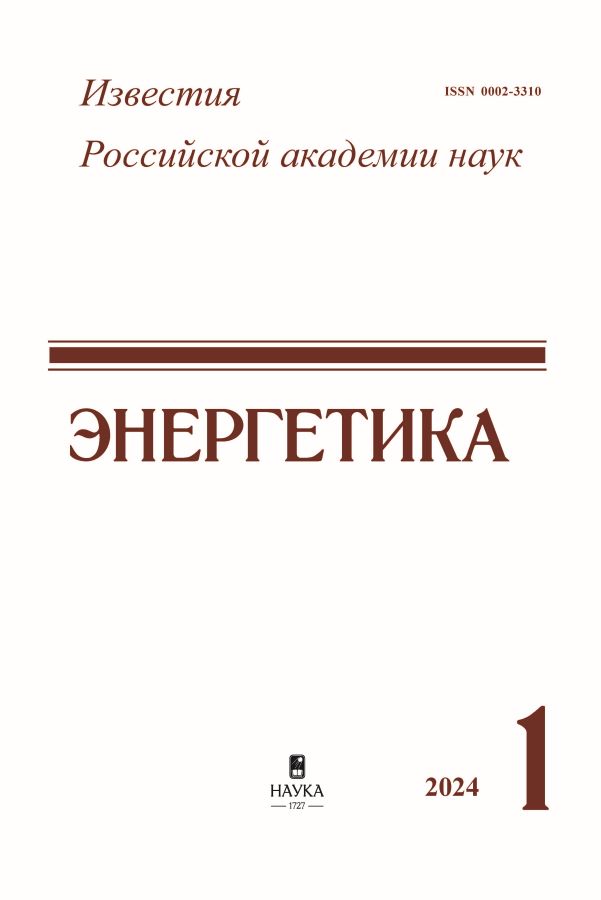Adaptive Control Algorithm Based on a Virtual Synchronous Generator. Part I
- Authors: Suvorov A.A.1, Askarov A.B.1, Ruban N.Y.1, Bay Y.D.1
-
Affiliations:
- Tomsk Polytechnic University
- Issue: No 1 (2024)
- Pages: 82-94
- Section: Articles
- URL: https://rjonco.com/0002-3310/article/view/660247
- DOI: https://doi.org/10.31857/S0002331024010103
- ID: 660247
Cite item
Abstract
In modern hybrid power systems, the total system inertia is not a constant value and at any given time depends on the share of renewable energy sources (RES) generation that are connected to the network via power converters. Because of this, the restrictions required in the power systems on the rate of change of frequency and the magnitude of its deviation during disturbances become difficult to achieve with conventional approaches and measures. Therefore, the transition to a new strategy of RES control, in which the power converter becomes the grid-forming, allowing the latter to perform a number of necessary system services, is relevant. To this end, a control algorithm based on the virtual synchronous generator (VSG), which imitates the properties and capabilities of conventional synchronous generation for RES units, can be used. However, due to constantly changing operating conditions in hybrid power systems, the virtual inertia formed by VSG must be adaptive. At the same time, the efficiency of adaptive algorithms largely depends on the VSG structure used. In this connection, the paper proposes a modified VSG structure for which the transfer function of the active power control loop is formed. It was used to perform a comparative analysis of traditional and modified VSG structures. The analysis results are proved that the developed structure does not have three principal contradictions. It is possible to flexibly control the modified VSG parameters to achieve the desired quality of the dynamic response at any stage of the transient process due to these special properties. The influence of tuning parameters on the inertial and damping properties of VSG is analyzed in the second part of the paper. The adaptive algorithms of the parameters changed depending on the emerging grid conditions have been developed on the basis of the obtained results. The obtained analytical results are confirmed by nonlinear dynamic simulation.
Full Text
About the authors
A. A. Suvorov
Tomsk Polytechnic University
Email: aba7@tpu.ru
Russian Federation, Tomsk
A. B. Askarov
Tomsk Polytechnic University
Author for correspondence.
Email: aba7@tpu.ru
Russian Federation, Tomsk
N. Yu. Ruban
Tomsk Polytechnic University
Email: aba7@tpu.ru
Russian Federation, Tomsk
Yu. D. Bay
Tomsk Polytechnic University
Email: aba7@tpu.ru
Russian Federation, Tomsk
References
- Tan B. et al. Power system inertia estimation: Review of methods and the impacts of converter-interfaced generations. – International Journal of Electrical Power & Energy Systems, 2022, vol. 134, 107362, doi: 10.1016/j.ijepes.2021.107362
- Лазарев Г. Б., Новаковский А. Н. Технологии применения синхронных компенсаторов в электрических сетях современных энергосистем // Энергетик. 2022. № 4. С. 59–69.
- Бубенчиков А. А., Бубенчикова Т. В., Шепелева Е. Ю. Анализ зарубежного опыта исследования систем генерации ветроэнергетических установок // Омский научный вестник. 2018. № 6 (162). С. 142–149.
- Илюшин П. В. Интеграция электростанций на основе возобновляемых источников энергии в Единой энергетической системе России: обзор проблемных вопросов и подходов к их решению // Вестник Московского энергетического института. 2022. № 4. С. 98–107.
- Андранович Б. и др. Интеллектуальное управление режимами изолированно работающей энергосистемы // Известия НТЦ Единой энергетической системы. 2021. № 1 (84). С. 61–66.
- Крамской Ю. Г. Интеграция возобновляемых источников электроэнергии в электрические сети с применением силовой электроники // Энергия единой сети. 2017. № 1 (30). С. 54–68.
- Соснина Е. Н., Шалухо А. В., Эрдили Н. И. Повышение эффективности использования возобновляемых источников энергии в составе виртуальной электростанции на основе мультиагентного управления // Вестник Чувашского университета. 2022. № 3. С. 103–113.
- Булатов Ю. Н., Крюков А. В., Суслов К. В. Изолированная система электроснабжения с энергетическими роутерами и возобновляемыми источниками энергии // Вестник ИжГТУ им. М. Т. Калашникова. 2021. Т. 24. № 2. С. 124–134.
- Rathnayake D. B. et al. Grid Forming Inverter Modeling, Control, and Applications. – IEEE Access, 2021, vol. 9, pp. 114781–114807, doi: 10.1109/ACCESS.2021.3104617
- Аскаров А. Б. и др. К вопросу о современных принципах управления возобновляемыми источниками энергии на основе виртуального синхронного генератора. // Вестник Пермского национального исследовательского политехнического университета. Электротехника, информационные технологии, системы управления. 2022. № 41. С. 5–30.
- Разживин И. А. и др. Оценка влияния ветроэлектростанций на изменение суммарной инерции электроэнергетической системы // Вестник Иркутского государственного технического университета. 2021. Т. 25. № 2 (157). С. 220–234.
- Bevrani H., Ise T., Miura Y. Virtual synchronous generators: A survey and new perspectives. International Journal of Electrical Power & Energy Systems, 2014, vol. 54, pp. 244–254, doi: 10.1016/j.ijepes.2013.07.009
- Суворов А. А. и др. Синтез и тестирование типовых структур систем автоматического управления на основе виртуального синхронного генератора для генерирующих установок с силовым преобразователем // Электрические станции. 2022. № 3 (1088). С. 43–57.
- Суворов А. А. и др. Управление сетевым инвертором на основе виртуального синхронного генератора при изменении плотности электрической сети // Электричество. 2023. № 3. С. 35–51.
- D’Arco S., Suul J. A., Fosso O. B. A Virtual Synchronous Machine implementation for distributed control of power converters in SmartGrids. – Electric Power Systems Research, 2015, vol. 122, pp. 180–197, doi: 10.1016/j.epsr.2015.01.001
- Li M. et al. Phase Feedforward Damping Control Method for Virtual Synchronous Generators. – IEEE Transactions on Power Electronics, 2022, vol. 37(8), pp. 9790–9806, doi: 10.1109/TPEL.2022.3150950
- Kundur P. Power System Stability and Control. McGraw-Hill, 1993, 1199 p.
- Суворов А. А. и др. Система автоматического управления силовым преобразователем на основе свободно конфигурируемой структуры виртуального синхронного генератора // Электричество. 2022. № 4. С. 15–26.
- Бесекерский В. А., Попов Е. П. Теория систем автоматического управления. СПб.: Профессия, 2003. 752 с.
- Сырчина А. С., Кулешов А. В. Синтез регулятора индикаторного гиростабилизатора с использованием критерия Вышнеградского // Известия Тульского государственного университета. Технические науки. 2022. № 11. С. 99–110.
Supplementary files


















